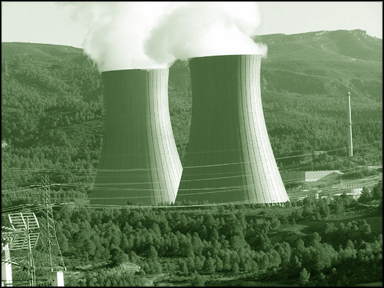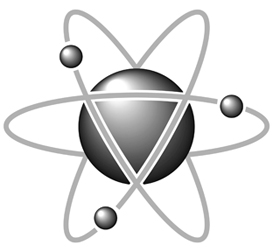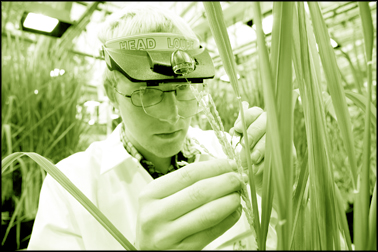|
Alternative energy options:
The many benefits of nuclear power
by Dhaneshi YATAWARA
The World Science Day is celebrated every year on November 10. Around
the world, this is the favourite day of scientists and enthusiasts. This
year, it will be a day for peace and development, giving us a hint of a
fresh view.
 |
|
A nuclear plant |
Developing the fields of science and technology is an investment for
any country, particularly benefiting the future generations. Though
development and peace should walk hand in hand in the growing up process
of a nation, many a times these concepts have clashed, as evident in
world history. One of the most severe problems would arise in the field
of power and energy. We are fast burning up our fossil fuel resources
while the generation of power with sun rays and wind is still in the
primitive stages. Around the world the demand for power and energy is
sky-rocketing. How do we meet this demand? Of course, the solution is in
the hands of no one else but scientists.
A perfect solution
The world needs a perfect solution to the increasing demand for
power. The survival of mankind and its civilisation depends on the
continued power or energy supply. Power and energy are the basics for
the development and growth of the human civilisation. According to
web-based reports, 14 per cent of the world energy needs was provided by
nuclear power two years ago. Though power generation using nuclear power
has shown no significant increase over the past two years, the tendency
of many industrial countries to divert themselves towards nuclear power
as an energy source has grown in leaps and bounds. As local and
international experts believe, the current state-of-the-art technology
would not leave room for another Three Mile Island or Chernobyl
incident.
The world is now more aware and cautious of the negative effects of
nuclear power.
Today, among the 30 countries that have nuclear power generation
capacity, the percentage of electricity coming from nuclear reactors
ranges from 78 per cent in France to two per cent in China. As of March
2008, there were 439 nuclear power plants around the world, while 35
more are under construction, latest statistics reveal. The USA has the
most with 104, France is next with 59, then Japan with 55 while Russia
has 31 and seven more under construction. The expansion in nuclear power
generation is centred in Asia. A total of 20 of the 35 plants under
construction are in Asia, while 28 of the last 39 plants connected to
the grid are also in Asia.
While technology is concerned, power plants that depend on atomic
energy do not operate that differently from a traditional coal-burning
power plant.
Both heat and convert water in to pressurised steam which drives a
turbine generator.
The key difference is the method of heating. Coal power plants
generate power to heat water by burning fossil fuels, whereas nuclear
power plants depend on the heat that occur during nuclear fission that
emits when one atom splits in to two. Thus the reaction results in a
different compound.
Uranium - 238 is the currently used raw material for nuclear power
generation.
Uranium 238, better known as U-238, is commonly found across the
globe. U-238 makes up 99 per cent of the uranium on Earth, while
Uranium-235 (U-235) makes up about 0.7 per cent of the remaining uranium
found naturally. Uranium-234 is even rarer, formed by the decay of
U-238. U-238 goes through many stages of decay in its lifespan,
eventually forming a stable isotope of lead; U-234 is just one link in
that chain.
Uranium constantly undergoes very slow spontaneous fission. This is
why the element emits radiation, and why it’s a natural choice for the
induced fission that nuclear power plants require.
The decay of a single U-235 atom releases 200 MeV (million electron
volts). That may not seem like much, but there are a lot of uranium
atoms in a pound (0.45 kg) of uranium. So many, in fact, that a pound of
highly enriched uranium, used to power a nuclear submarine, is equal to
about a million gallons of gasoline.
 The radioactive waste - the exhausted raw material used to generate
power - has become a major problem for those countries who are
converting to nuclear power as a main source of energy. The world has
found a solution yet it has not shown much success, being unable to
impress the concerned parties who urge a total solution. Theoretically,
the atomic reaction is reversible. Thus waste can be converted to its
original compound, experts say referring to the theories. How cost
effective and reliable the process could be is still doubtful. The radioactive waste - the exhausted raw material used to generate
power - has become a major problem for those countries who are
converting to nuclear power as a main source of energy. The world has
found a solution yet it has not shown much success, being unable to
impress the concerned parties who urge a total solution. Theoretically,
the atomic reaction is reversible. Thus waste can be converted to its
original compound, experts say referring to the theories. How cost
effective and reliable the process could be is still doubtful.
But, undoubtedly, the cost would be unbearable for developing
countries like Sri Lanka. Still, do we need to dump the atomic power
concept solely due to its waste material disposal problem? No need for
that. As mentioned above, our scientists have proven that we can use the
technology within our limits, thus developing the economy. It only needs
a fresh view, standing out of the frame.
Peaceful uses
Nuclear energy for peaceful use is the novel concept the Sri Lankan
Atomic Energy Authority is presently concentrating on. Sri Lanka’s
Atomic Energy Authority (AEA) is in the process of exploring the
possibility of using nuclear energy for future power generation, said
Science and Technology Minister Professor Tissa Vitarana, addressing a
recent media briefing, held to announce the start of these feasibility
studies.
It was revealed at the media conference that the Ministry of Science
and Technology has advised the AEA to set up a National Committee on
Nuclear Power to study nuclear power as an alternative energy option.
This committee which will include academics from the Moratuwa
University, officials of the Ceylon Electricity Board and AEA and other
experts will be formed soon. According to Ministry sources, the concept
depends on the country’s thorium resource. Nearly 30 per cent of the
world’s thorium resources are reported to be in the South Asian region -
i.e. Sri Lanka and India. So far, thorium resources have not been tapped
for power generation. According to reports India is planning to use its
thorium resources for the country’s second generation of nuclear power
plants. Sri Lanka’s thorium resources are found to be based along the
coastal line from Kalutara to Beruwala and in the Eastern Province.
Though power generation by splitting atoms seems to be a distant
dream, we have used radioisotopes, an initial stage concept in atomic
power, in several instances. There are many success stories of the
technology being applied in the local context during the past few years.
Tissue preservation
The Human Tissue Bank is the Model Project of the International
Atomic Energy Agency (IAEA), implemented in Sri Lanka as a joint effort
of the Eye Donation Society, AEA and the Ministry of Healthcare and
Nutrition. In this facility all tissues are sterilised by gamma
radiation at a dose of 25 kGy (Kilo Geiger). The Human Tissue
Transplantation Act No 48 was passed in 1987, legalising tissue
procurement and transplantation in Sri Lanka. This act has stipulated
the terms and conditions under which the extraction, processing,
storage, retrieval and utilisation of human tissues should be performed
in Sri Lanka. It has covered all the legal requirements protecting
donors, doctors and recipients.
The Human Tissue Bank is one of the successful projects of radiation
technology in Sri Lanka which was supported and coordinated by the AEA.
The Model Project SRL/7/003 approved by the IAEA envisages a
multi-tissue bank dealing with all donor tissues including amnion, skin,
bones, soft tissues (including tendons, ligaments, pericardium, fascia
lata and eye sclera).
Food testing
In 2001, a food quality laboratory was set up in Sri Lanka as a
project implemented by the AEA under a technical cooperation program of
the IAEA.
The need for food testing came to light with the increased demand
which developed during the rapid growth phase of the poultry and
aquaculture sectors in Sri Lanka. With the present laboratory set-up,
services are provided to broiler processors, shrimp exporters and milk
producing companies in Sri Lanka. The service is also obtained by
regulatory authorities including the Ministry of Fisheries and Aquatic
Resources and the Quarantine Division of the Department of Animal
Production and Health. Clearance for shrimp exports is provided by the
Ministry of Fisheries based on the test results of the laboratory.
The Technical Cooperation Programme of the IAEA facilitate the
development of laboratory infrastructure through provision of essential
equipment, training for human resources development, expert missions and
scientific visits. These inputs helped immensely in capacity building of
the staff, and introducing modern technology for food quality assurance.
The counterpart funding for implementing the program was obtained
through research grants of the University of Peradeniya, National
Science Foundation and Council for Agricultural Research Policy.
Since Sri Lanka’s export market depends mostly on spices, fruits and
vegetables and several other food items, sterilisation by irradiating
the food products adds greater value to the product, making it possible
to demand a higher price. The irradiation methods do not have harmful
effects on the food items, thus making them safe and effective methods
to sterilise these export goods.
Livestock development
Though radioisotopes are commonly used in researches around the
world, Sri Lanka has used them as a tool only in a few instances. They
made a major contribution to a research done as a joint operation of the
Food and Agriculture Organization and the IAEA, following the 1996 World
Food Summit held in Rome.
The research done by Professor Oswin Perera and Dr. M.C.N. Jayasuriya,
who were then attached to the University of Peradeniya, brought results
that were extremely helpful to upgrade the livestock industry, not just
in Sri Lanka, but for many developing nations.
Many of the advances which have been made in improving feeding,
fertility and health of livestock in these countries would not have been
possible without nuclear technologies. By using both stable and
radio-isotopes, scientists have come to understand and then to
manipulate for greater productivity, the biological processes
responsible for growth, production, re-production and disease resistance
in different types of farm animals.
“On average, livestock accounts for half of agricultural output when
both their direct and indirect contributions are considered,” says Dr.
M.C.N. Jayasuriya in his article `Use of Nuclear Techniques in Livestock
Productivity’ published following the research.
“Secondly, they are an important component of traditional
agriculture, complementing arable cropping. Their contribution to the
economic welfare of the people extend beyond the traditional uses of
supplying meat and milk.”
 |
|
Nuclear technology is
used in agriculture too |
The researchers state that although nearly 80 per cent of the human
population and 70 per cent of the cattle, 60 per cent of sheep and 93
per cent of goat population live in developing countries, only 34 per
cent of the world production of fresh milk equivalent and 48 per cent of
the production of meat are from these countries. And the role of
livestock in the human food chain in developing countries is complex and
significantly different from the situation in industrialised countries.
First and foremost, by providing meat, milk and eggs, livestock provide
a crucial source of high quality protein, minerals and vitamins,
especially for children and pregnant and nursing women.
According to the researchers, the inability to feed animals
adequately throughout the year is a major constraint to improving the
livestock industries in developing countries though the breeds and types
of livestock in developing countries are well known for their greater
tolerance to environmental stresses, fluctuating levels of nutrients and
resistance to diseases.
As Dr. Jayasuriya explains in his article, the impact of using
isotopic techniques has been most visible in the area of developing
feeding strategies for farm animals. For example, isotopic markers have
been used in the development of feeding strategies for ruminant
livestock such as cattle, buffaloes, sheep and goats. Both radio active
(14C, 125I, 51Cr) and stable (15N) isotopes have been used as `markers’
to understand how micro-organisms in the rumen or the fore-stomach of
cattle, buffaloes, sheep and goats digest grass and other forages and
how the energy, protein, minerals and vitamins produced from these feeds
are used in building body tissues or producing milk.
“With the development of highly sensitive immunoassay methods, in
particular radioimmunoassay (RIA) using 125I or 3H, it is now possible
to measure these hormones which circulate in blood and other tissues
such as milk. The measurement of the reproductive hormone progesterone
in blood or milk in particular has been valuable for monitoring the
reproductive function of the females of most domestic animals.
Progesterone produced in the ovary reflects the sexual activity of the
animal.
By measuring the level of progesterone using RIA, it is possible to
determine when animals are ready for breeding, diagnose pregnancy at the
early stages or diagnose non-pregnancy so that animals can be bred again
without losing productive lifetime, check whether animals have been
correctly inseminated, detect reproductive disorders and devise
corrective measures to overcome them. RIA has been highly effective in
the more advanced embryo transfer programs.
“Immunoassay methods can also monitor meat and other food products
for potentially harmful substances and therefore safeguard their
quality,” the researchers state. |

